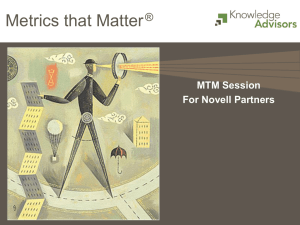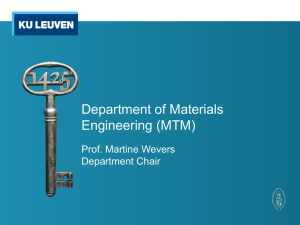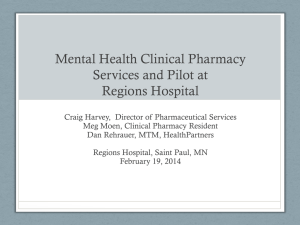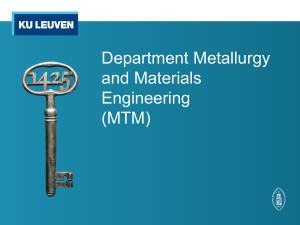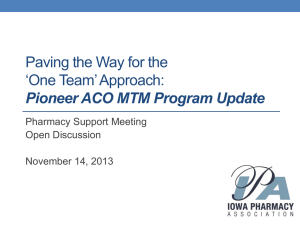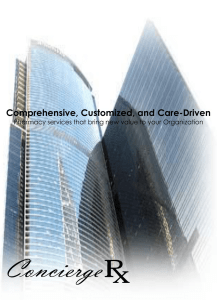Appendix - C - Community Pharmacy Foundation
advertisement
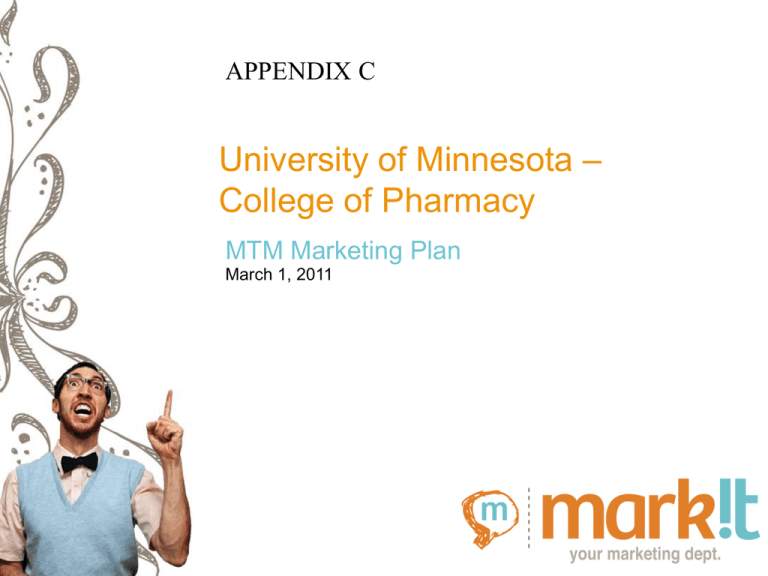
APPENDIX C University of Minnesota – College of Pharmacy MTM Marketing Plan March 1, 2011 Table of Contents 1.Focus Group Research Results 2.MTM Marketing Plan Six month Goals Target Audience Definition Issues Key Messages Strategies and Tactics Reporting Requirements Focus Group Research Results Methodology • Conducted 6 focus groups – Sterling Drug, Albert Lea, MN Mayo Pharmacy, Rochester, MN Goodrich Pharmacy, Anoka, MN Cub Foods, St. Paul, MN Walgreens, St. Paul, MN Guidepoint, Brainerd, MN • Participants attended a 2 hour group discussion on MTM to understand their attitudes, perceptions, beliefs and behaviors concerning MTM. • Participants were recruited by the individual pharmacies based on their eligibility for enrollment. • A DVD was shown half way through the group time that explained what MTM is. Current Drug Therapy Program Role of the Physician • Considered to be the authority on what medications are best for the patient. • Understand what the patient is taking. • Understand the side effects of medications they prescribe, and how different medications interact with one another. • Provide education to the patient on medications. • Follow up to insure patient effectiveness. • This view changes depending on the patient’s relationship with their doctor. • The more trust there is in the relationship, the more highly regarded the advice. Current Drug Therapy Program Role of the Pharmacist • Viewed as a “coach” or “advisor” on medications. • Monitor medications, patient safety. • Answer questions patient may have. • Tell patient what to expect. • Suggest alternatives. • Help address cost and insurance issues. • Provide recommendations on OTC products. • Viewed as more available than their doctor, and will spend more time with the patient. • Viewed as a part of the patient’s care team, without the intimate knowledge of the patient that the doctor has. Current Drug Therapy Program Issues with their current program • Multiple concerns exist regarding the use of medications. • Timing of administration of various medications, adherence to dispensing of medications. • Overdosing on medications. • Mail order programs, no pharmacist relationship – no one to talk to when needed. • Notification when medications change in size, dosage, shape. • Most had not experienced a negative drug interaction and were not overly concerned about it. There was a direct correlation between satisfaction with physician and concern over issues with their medications. Reactions to MTM (prior to viewing video) Awareness of what MTM is • There is general confusion about what MTM is, though not surprising given the newness of this concept to the market. • Respondents reported that MTM ranged from a pill box to an integrated system of managing the patient’s medication needs. • They did feel this was something that a patient would have a greater need for the more medications used. • Overall concern regarding how to handle information that might be contradictory to their physician. Reactions to MTM (following the viewing of the video) Understanding of the concept • Participants were able to grasp the concept of what MTM is from the video. • Attitudes towards MTM were very positive, high value was placed on the pharmacist being a member of the healthcare team. • Respondents felt insurance companies should cover cost of MTM, the benefit to them is reduced medication costs. • Service is more accepted with the support of the physician (the physician continues to play the lead role in the healthcare team). Reactions to MTM (following the viewing of the video) Participants rank ordered the benefits of MTM, from most important to least important, as follows: • Optimizes the safe and effective use of medications. • Improves my treatment outcomes. • Improves my quality of life. • Gives me confidence that I am doing the right things for my best health. • Promotes collaborations between pharmacists, physicians and patients. • Allows me to manage my medications, they don’t manage me. • Provides me with a written record of my conditions and medications. Reactions to MTM (following the viewing of the video) Insurance related issues • Participants felt MTM should be covered by insurance. • Structure should include an initial visit, with subsequent visits dependent upon changes in medication or health status. • If insurance did not cover MTM visits, participants felt they would use the service only under more severe circumstances. • While most had no idea what the service was worth. Some were able to put a value of $50 per hour on the service. • No one knew that MTM was a benefit of Medicare Part D if you are taking 4 or more medications. Reactions to MTM (following the viewing of the video) Views on the name – Medication Therapy Management • Participants felt the term “therapy” was confusing and not necessary. • Participants do not think that their medications are a form of therapy, they think of therapy as in “physical therapy.” • Participants liked the term “medication management” better and felt it was descriptive of the concept. Reactions to MTM (following the viewing of the video) How to reach the target audience • Participants want to know that their doctor is in support of them participating in an MTM program. • They need to know that members of their healthcare team are working together for their benefit. • They would attend an MTM session at their doctor’s recommendation, some said though that they thought their doctor would not agree to it. • Upon doctor’s recommendation they would attend if contacted by the pharmacist, either by a face-to-face conversation or a phone call from the pharmacist. • Letters or calls from anyone other than the physician or pharmacist would not be received as well. MTM Marketing Plan Six Month Goals • Increase enrollment of MTM eligible patients by at least 5-10%. • Acquire an understanding of the most successful approach to attract new MTM patients. • Educate physicians on the enhanced role the pharmacist can play in the health of their patient. • Educate patients on the valuable service that is available to them to optimize the benefits of their medications. Target Audience – Patricia and John Patricia and John are a retired couple. He was an electrician and she was a school teacher. John has diabetes and high blood pressure. Patricia has high cholesterol and has had one heart attack. Both take multiple medications for their conditions. They visit their doctors regularly and are proactive in managing their medical conditions. Patricia and John have a modest income, but do enjoy traveling when they can. They also like to keep active by volunteering, and visiting with friends and family. They view themselves as hardworking, caring, compassionate people who enjoy being around others. Patricia and John are not familiar with what MTM is, but do have insurance that covers it. They feel the role of their pharmacist is to be an extra set of expert eyes to help manage their medication therapy. The pharmacist is a person they have a relationship with. They trust them and feel they can go to them with questions. Issues • Getting physicians on board with the concept is critical to the program’s success. • Physicians may view this program as a threat to their role with patients. • The role of the physician and pharmacist need to be clearly defined and understood as a benefit to the physician. • A system of communication needs to be developed to share pharmacist recommendations that is not driven by the patient. • Increasing stakeholder awareness of the pharmacists clinical abilities is needed. Issues con’t • Differentiating prescription counseling from MTM, people have no concept of what to expect from an MTM session. • There is a huge educational component to this program. • To physicians – - value of working together with the pharmacist for the benefit of the patient - role that the pharmacist is capable of playing • To consumers – - benefits of the program - support of physicians - coverage by Medicare Part D - role that the pharmacist is capable of playing Key Messages Key messages are important in the communication of the benefits of the program. Messages have to meet three criteria. They must be relevant, believeable and distinctive. The following are the top three messages identified by focus group participants as meeting the criteria. Use of these messages in the verbal and written language you use to describe MTM will resonate with your audience. Key messages are: • Optimizes the safe and effective use of medications • Improves my treatment outcomes • Improves my quality of life Strategies and Tactics Product One of the aspects of a successful program is a visible relationship between the physician and the pharmacist. The patient has a strong belief that the physician is the leader of the team. The pharmacist plays more of a specialist role. An MTM meeting includes a review of the medication list and of medical issues, discussion of drug related issues/concerns, and recommendations for change. MTM consists of an initial visit. Subsequent visits occur when the patient has a change in their medical situation or when another medication is added to their list. “Medication Therapy Management” is not an appealing name. The recommendation is to drop “Therapy.” Strategies and Tactics Product con’t 1.Determine a name for your program – Medication Therapy Management, Medication Management, Medication Check-up are a few possible names. 2.Establish protocols for the patient meeting and physician follow-up. - Document these protocols as they will be valuable in talking with physicians and other interested parties. 3.Establish a tickler system that prompts you when an MTM patient has a new medication (for follow-up MTM sessions) - When prompted, contact the patient and suggest a date and time to get together for a review. Strategies and Tactics Price Based on the research conducted, it is not very likely that consumers will pay for this service out of their pocket. Therefore, the focus should be on recruiting patients that have insurance coverage for the service. Cost for MTM services should be calculated in accordance with the guidelines provided by the individual companies. 1.Investigate which insurance companies provide reimbursement for MTM consultations. 2.Identify, based on the program, what you will charge for the consultation. Strategies and Tactics Place From the consumers point of view, where the MTM session is conducted is not a particular issue. If it makes sense, consultations could be done in the patient’s doctor’s office. Or, it could be done in the pharmacy. What is required is a private, enclosed space. 1.Define a designated space to conduct MTM sessions. 2.Identify patients from your database that would be good candidates for MTM. They are: - Taking multiple medications - Have insurance coverage for MTM visits - Have a good working relationship with your pharmacy - Have a physician that you feel is already, or would be, supportive of the program Strategies and Tactics Promotion Awareness for what an MTM program is is very low. In the initial stages of a program launch, you will need to educate your audience. A critical factor is the visible relationship between pharmacist and physician. Getting the support of the physician with their patients will increase the participation rate. Tactics for a new MTM program: 1.Create a brochure or information flier as a leave behind piece when talking with physicians about the program. The piece could also be used by physicians to recommend MTM to patients. - Benefits of MTM - How MTM is different than pharmacist consultation - What the process is Strategies and Tactics Promotion con’t 2. Work with local physicians to get support for conducting MTM sessions with their patients whom you have identified. - Conduct in-service sessions to educate doctors on the benefit of MTM for them, and protocols for patient meetings and physician follow-up. 3.Schedule follow-up meetings with physicians that attend the inservice to talk with them about specific patients that could benefit from an MTM consultation. - Determine who will contact the patient to schedule a meeting. - Face-to-face or phone call contact from either the pharmacist or physician is best. It sends the message that MTM is important. Strategies and Tactics Promotion con’t 4. If a patient is on your target list, talk to them when they are in the pharmacy to pick up a prescription. Strategies and Tactics Promotion con’t Assuming you have the support of local physicians, the next level of marketing can be focused on enhancing awareness directly with patients. Tactics to enhance an existing MTM program: 1.Increase awareness of what MTM is with local service clubs, senior centers, or associations whose members fit the target audience profile - Create a short 15 minute presentation that talks about what MTM is, the benefits of MTM, what an MTM consultation consists of, and some examples of how it has helped your patients. Utilize the MTM DVD that has been provided with this plan as an additional source of information for your audience. Strategies and Tactics Promotion con’t Tactics to enhance an existing MTM program con’t: - Get a commitment for a date to speak to the group. - Talk with the head of the organization and ask to be a speaker at a membership meeting. 2. Add information regarding your MTM program to your website. 3. Utilize bag stuffers, buttons, and in-store posters to raise awareness of your MTM program. Reporting Requirements From March 1 to September 1 you are participating in this pilot program. You will be in contact with Julie Hedlund and Brian Isetts on a monthly basis to discuss what is working, what’s not, what needs more support. In order to facilitate these discussions, we ask that you document your experiences on a weekly basis. In between our monthly calls, if you feel you have an issue that needs more immediate attention, please feel free to contact us at the numbers below. Brian Isetts Julie Hedlund 651-301-1804 (c) 507-424-2802 (o), or 507-254-2056 (c)

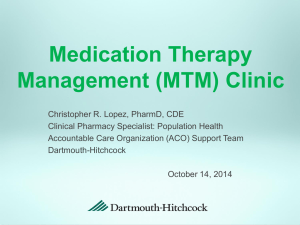
![Masood Textile Mills [Erum Zahoor]](http://s2.studylib.net/store/data/005544654_1-c63f8378e6188468be9b937fd88ad22c-300x300.png)

